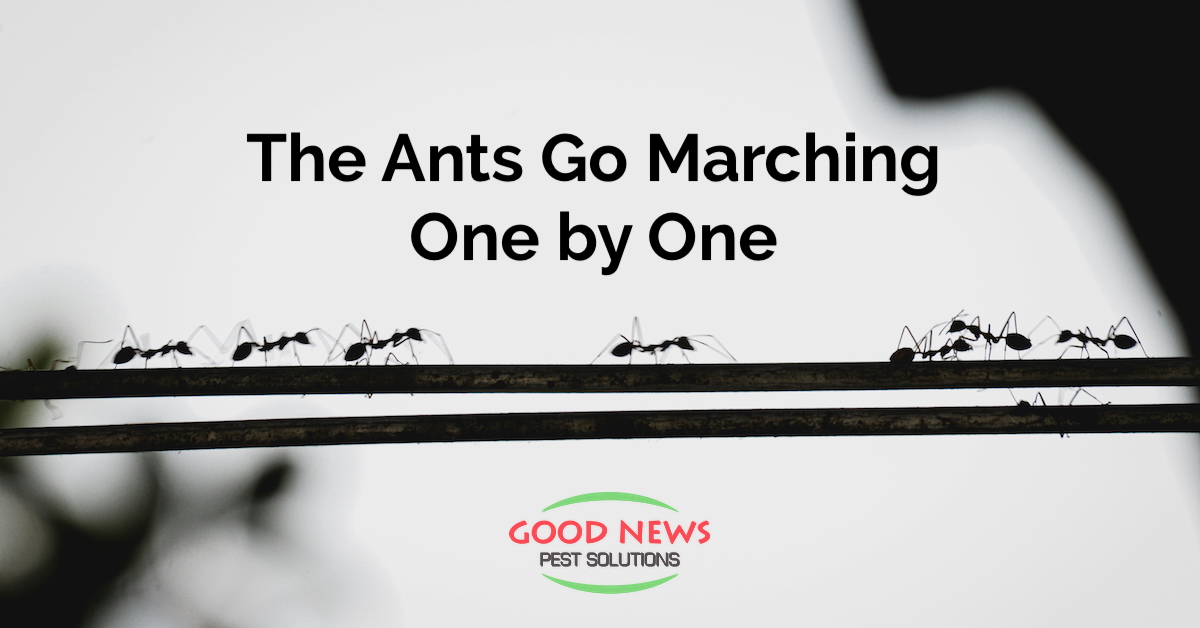
The Ants Go Marching One by One
"The ants go marching one by one, hurrah, hurrahThe ants go marching one by one, hurrah, hurrahThe ants go marching one by one,The little one stops to suck his thumbAnd they all go marching down to the groundTo get out of the rain, BOOM! BOOM! BOOM!"
"The Ants Go Marching" is a popular childrens' song that teaches counting in a sing-along structure. But like most nursery rhymes, it actually has an even deeper historical meaning. The writer of Proverbs in the Bible points out how industrious ants are. When you see a line of ants, they’re clearly on a mission. But how do they stay in almost perfect straight lines – and why? Is there a purpose we can’t see?
Anatomy of an Ant
For what it’s worth, ants can see even less than we do, which may make their marching stance even more remarkable. But they possess certain attributes that we humans don’t. For example, they have antennae that provide much of their sensory input.
Ants use their antennae for seeing, smelling, touching, tasting, and sensing vibrations. It was also recently discovered that ants’ antennae are a two-way communication system. Those are some very functional body parts! So ants “see” through their antennae, but they also enhance that sight with pheromones, which is where the straight line comes in.
Ants are kind of the original foragers. They’re always on the lookout for food or water. So when they find a tasty treat, they head back to the colony, laying down pheromones like breadcrumbs so not only can they find their way back, but so can other members of their nest. There are even differing layers of these odorous chemicals.
If it’s a really good find, other ants will track, in an almost perfect straight line, that pheromone, and leave more behind. The original scavenger can leave a larger trace if the food is plentiful and would require multiple ants to carry it. On the other hand, if it’s not what was promised, or has disappeared, subsequent ants can mark the trail with highly disposable pheromones that evaporate once the food is loaded up.
The ants register these chemical tracks in their antennae and follow them to their source, kind of like following a GPS that connects to your nose rather than satellites. But that’s just the start. Some species of ants can create a two-way street, one leaving and one returning to the nest.
Ants can also use pheromones to warn other ants of danger or coordinate an attack, as anyone who’s stepped into a fire ant mound has found out the hard way.
Finding Purpose
In a nest or colony, different ants have different jobs – and some even change jobs as they get older. Like honeybees, ants have a queen. But ants are split into monogyny nests, with one queen, and Polygyne colonies, with multiple queens. Super colonies can have dozens or even hundreds of queens. One species in Japan, the Formica yessensis, or Japanese red wood ant, was estimated to contain 306 million worker ants and one million queen ants living in 45,000 nests interconnected by underground passages over an area of 670 acres!
Male ants are the most specified of the ants. They exist for one purpose only - to mate with the queen. All of the other worker ants are females. They handle the chores of foraging for food and supplies, feeding the larvae, taking out the colony's trash, and defending the nest. The ant species M. smithii, found in Central and South America, are exclusively female. The queen ant essentially clones herself thousands of times to produce a colony.
Army Ants don’t have a home per se. In their nomad phase, they will travel all day, attacking other colonies and insects they encounter for food, build a temporary nest and continue on. When the queen is ready, they shift into stationary mode. She lays her eggs and they build a nest out of their own bodies to protect the queen, the eggs, and their gathered food supply.
Sadly, sometimes nature gets the better of the industrious ant. There is a fungus that can infect ants and take control over of their bodies, turning them essentially into zombies. In fact, the video game and TV show The Last of Us uses this idea - a mutated cordyceps that turns humans into infected beings. In real life, the ants are driven to climb to the top of a plant, bite down and die, sending fungal spores to infect ants in a wide radius.
Florida Ants
Here on the Gulf Coast of Florida, we have around 200 different species of ants. Invasive red imported fire ants are usually the first ants new folks encounter, unfortunately very painfully. Carpenter ants will also bite to defend themselves, but usually also keep to the outdoors around rotting wood.
When we’re called to treat home ant infestations, these are usually pharaoh ants, crazy ants, ghost ants, big-headed ants and thief ants. These are generally more of a nuisance than a threat, but they can contaminate food and several species can cause structural damage to your home. Most, thankfully, don’t make it indoors, but when temperatures start to dip, some may be more aggressive about finding a way inside.
The other thing to watch out for is displaced ants due to hurricanes or even just heavy rains. If your yard is full of puddles, be on the lookout for mosquitoes of course, but also ants in search of somewhere stable and dry to camp out.
Ants are one of the primary pests our Go Green Perimeter Plus treatment specifically targets, along with cockroaches and spiders. We inspect your home and yard, identify potential entry points and then use our green treatments to eliminate pests while keeping your family safe. For more details, or to schedule your first appointment, just give us a call!
« Back to BlogProudly Serving
Sun City Center, Ruskin, Palmetto, Parrish, Ellenton, Bradenton, Anna Maria, Holmes Beach, Bradenton Beach, Longboat Key, Lakewood Ranch, University Park, Myakka City, Sarasota, Siesta Key, Osprey, Nokomis, Casey Key, Venice, Englewood, North Port, Port Charlotte, Punta Gorda, Arcadia
Things You Can Do
Pay Your Bill Online
Leave Us a Review
Request a Free* Termite Inspection
Stop Mosquito Bites
Get Rid of Rodents
Get a Termite Damage Warranty
Get Pest Control for Your Attic
Get Pest Control for Your Business Request Prayer
Corporate Address
1080 Enterprise Court, Ste A
North Venice, FL 34275
Call Now: (941) 412-9610
Text: (941) 412-9610
Fax: (941) 412-0080
